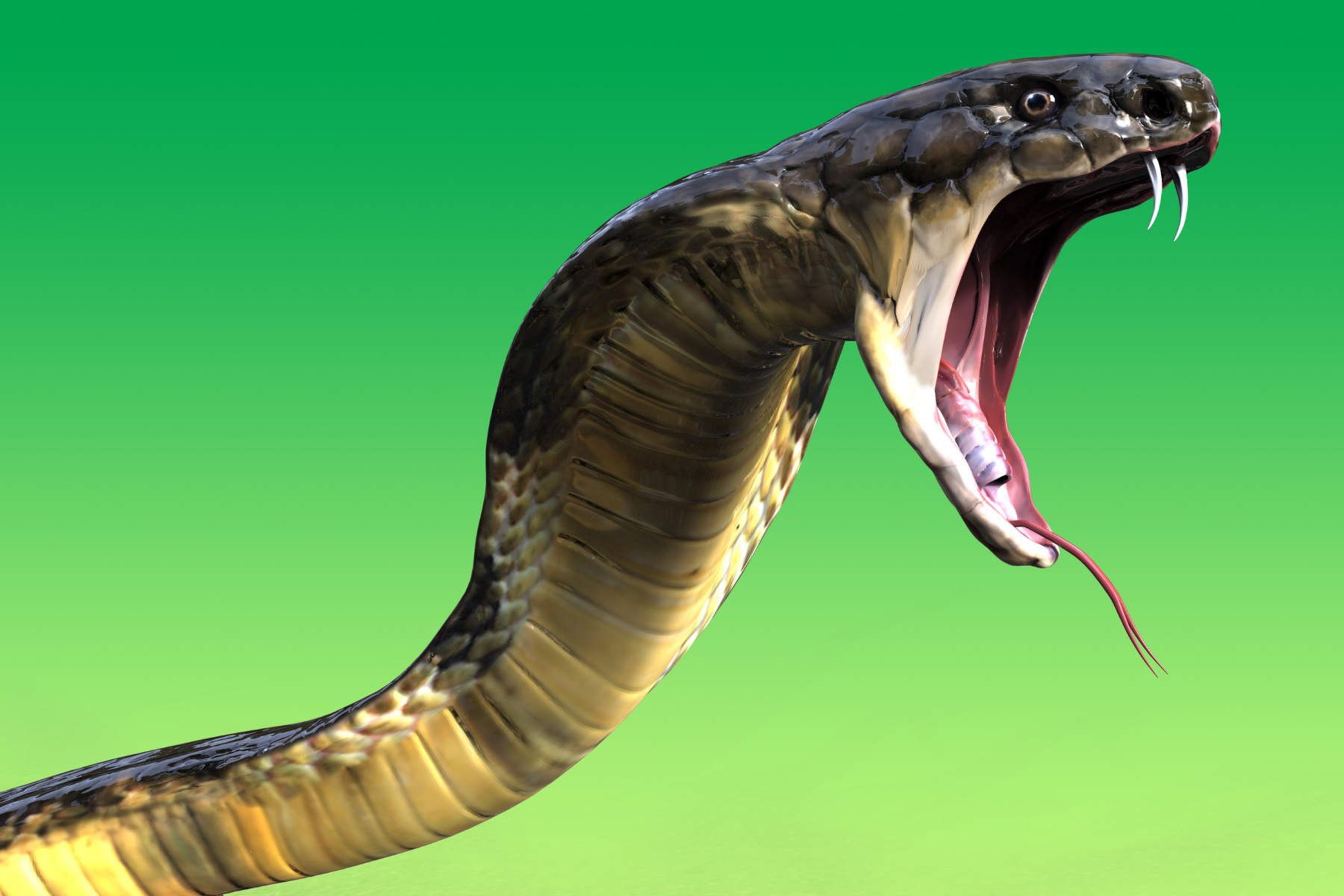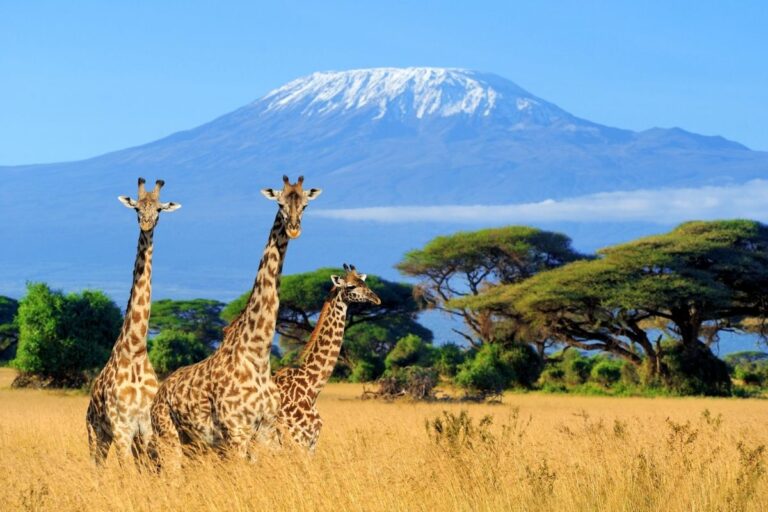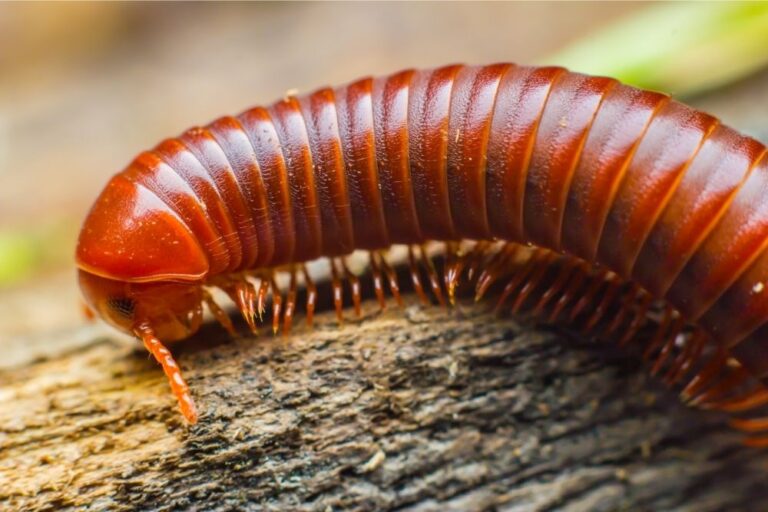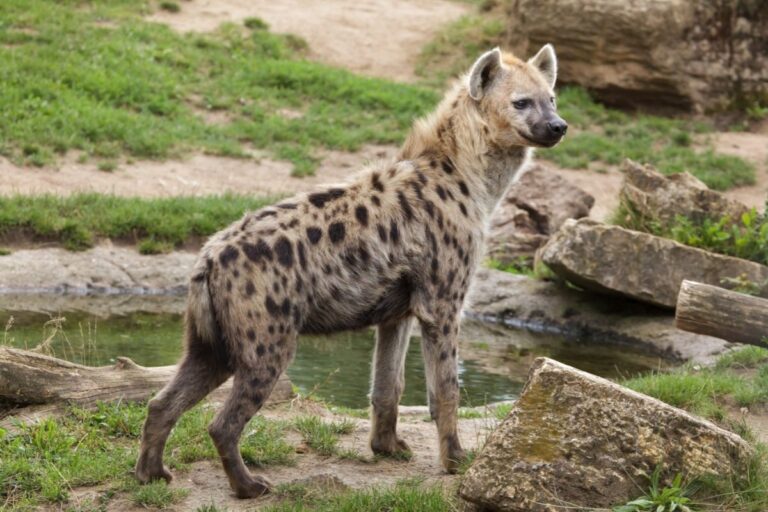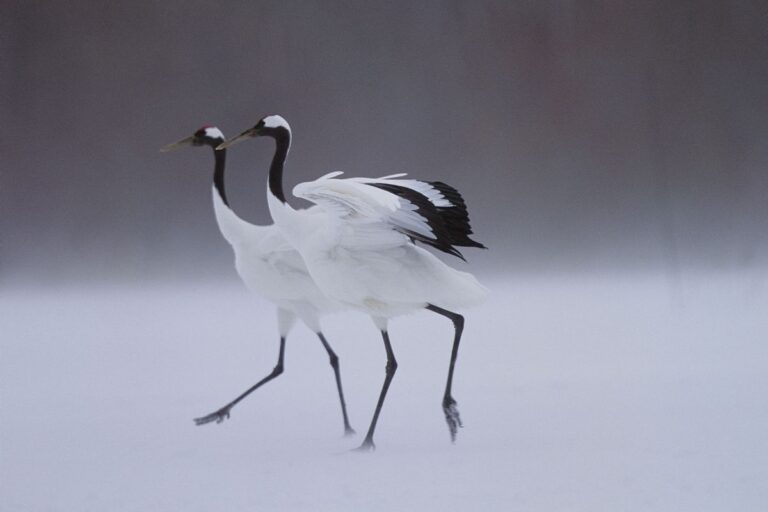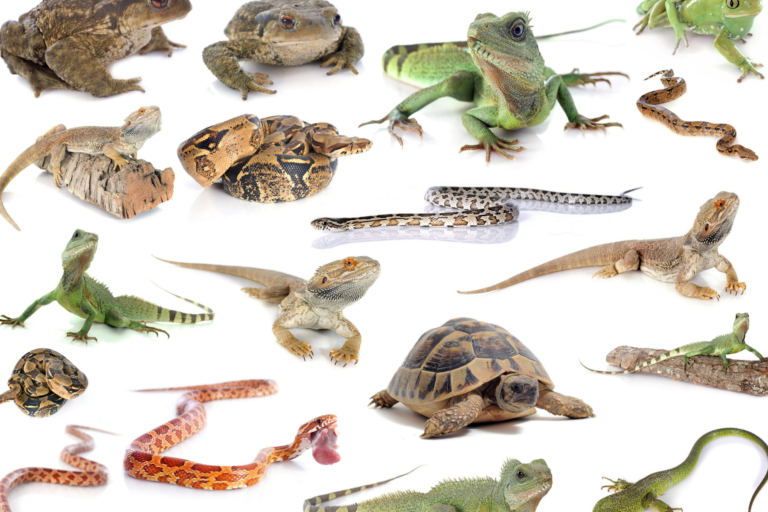200 Interesting Animal Facts You Should Know
Last Updated on September 19, 2021 by
In honour of World Animal Day, we have compiled a list of 200+ interesting animal facts to help you understand how diverse and fascinating the animal kingdom is.
Each creature is unique, having its own special feature or abilities. Animals are the most diverse group of organisms on Earth, with over 1.5 million animal species identified so far and new species being discovered every year. With so many animals to choose from, there were a lot of animal fun facts we could come up with!
To feed your curiosity about animals, here are 200 unusual facts about animals that will change your perspective about them.
200 Facts About Animals
1. Foxes make gekkering sounds.
Foxes don’t make a “ring-ding-ding-ding-dingeringeding” sound, but they are known to gekker or create throaty vocalizations in an irregular pattern. They usually make this unusual noise when they confront a predator or a rival.
2. An ostrich egg is comparable to 24 chicken eggs.
Ostriches are the largest bird species on the planet, so it is no longer surprising that they lay the hugest eggs. In fact, an ostrich egg, which can weigh up to two kilograms (4.4 lbs.), is equivalent to 24 average-sized chicken eggs.
3. Basenjis are the only dogs that don’t bark.
Basenji is the only dog breed that doesn’t bark because its larynx is flat compared to other dogs. However, it does make some sounds similar to coughing or yodeling, which might be unusual to most pet owners.
4. The monarch butterfly has 12,000 “eyes.”
Just like any other butterfly, the monarch butterfly has only a pair of eyes. However, this winged insect has 12,000 miniature eyes, also known as ommatidia, allowing one to see everything from all angles and directions.
5. Octopuses and squids are blue-blooded creatures with three hearts.
Octopuses and squids do not belong to any royal family. However, their blood is blue-colored because of the copper present in the oxygen-carrying protein called hemocyanin.
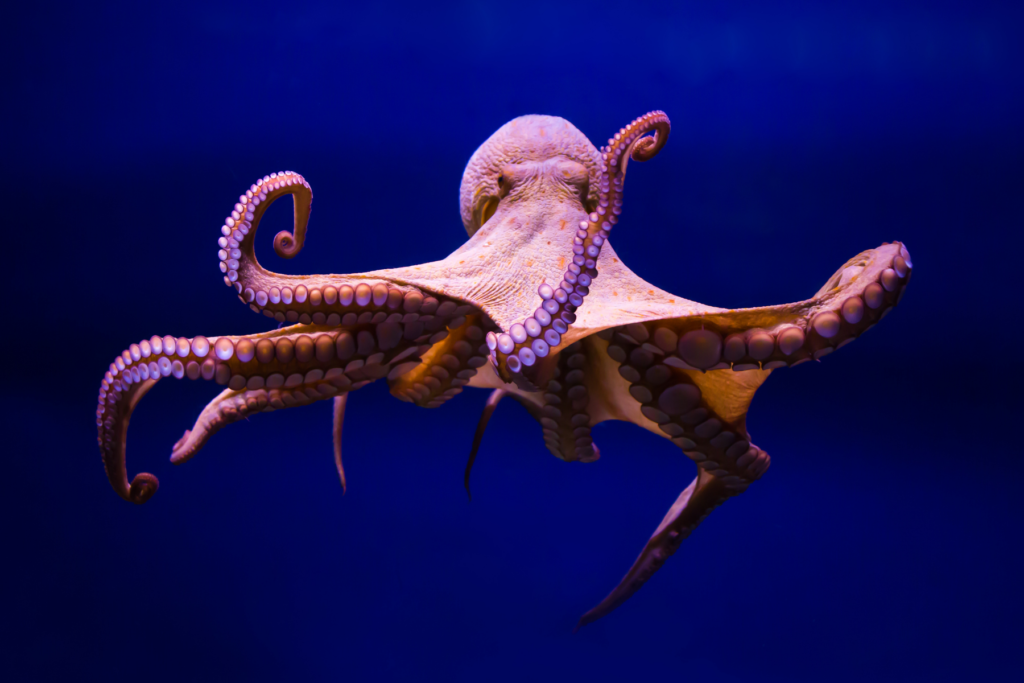
6. Flies know how to sanitize themselves.
Contrary to people’s belief about flies being some of the dirtiest insects in the entire world, flies are actually “clean” insects. They sanitize themselves by rubbing their forelegs on their eyes, mouth, and wings to remove food remnants or particles like pollen and dust.
7. The bug Belgica antarctica is one of the three insects that dwell in the Antarctic region.
Despite the climate’s extremity in Antarctica, the black midge Belgica antarctica can survive on its own by feeding on microorganisms settling in the cold.
8. The box jellyfish has the deadliest venom among all creatures.
While this transparent, free-floating creature looks fragile, the box jellyfish (or box jelly) has the deadliest venom in the world. It is so poisonous that its venom can cause any animal or human to undergo cardiac arrests and damage your nervous system, which can kill you in 30 seconds.
9. This jellyfish can defy mortality.
The free-swimming marine Turritopsis dohrnii can cheat death unless consumed by a predator or struck by a disease. This undying jellyfish can regenerate its cells, even the dying ones, to their healthiest state and repeat the whole life cycle.
10. The colossal squid has eyes as colossal as soccer balls.
The colossal squid lives up to its name, for it is one of the largest cephalopods alongside the giant squid. As a matter of fact, its eyes are as big as an average soccer ball.
11. Fleas don’t fly; they jump.
Fleas are tiny wingless parasites relying on their powerful high-speed jumping skills to transfer from one place to another. Adult fleas arch their exoskeleton before leaping and use an elastic protein called resilin to make that big jump without breaking their legs.
12. Whale sharks have the thickest skin among all animals.
Skin is indispensable for animals against the weather and predators, and a whale shark’s skin never disappoints. Its hide is four inches thick, hence, known as the thickest animal covering ever recorded.
13. Polar bears are black-skinned creatures.
Polar bears may appear white because of their fur, but underneath the furry coat lies their black skin. Their white hair is only a front to blend with their natural habitat covered in snow and glaciers.
14. Male seahorses give birth to their tiny babies.
For seahorses, gender doesn’t matter when it comes to giving birth. Fertilization occurs in the male’s brooding pouch. The female puts her mature eggs inside the male’s brood pouch for fertilization and gestation. After a few weeks, the male seahorse ejects these young fries out of his brood pouch.
15. Giraffes are not mute; they know how to hum.
Zoologists have been trying to discover a giraffe’s sound for a long time. Recently, scientists have found that giraffes create low-frequency vocalizations or humming at nighttime as their possible way of communicating with other giraffes.

16. Shrimps have hearts located in their heads.
Most animals have their heart/s located somewhere in the upper torso or chest area, but it isn’t the case for shrimps. In fact, you can find a shrimp’s heart at the bottom part of its head.
17. The Dumbo octopus is the deepest living octopus in the world.
Discovered in 2016, the Dumbo Octopus lives in the deepest parts of the oceans 4, 000 meters deep. It also got its unique name from a Disney character named “Dumbo.”
18. Dolphins produce sound waves and whistles to communicate underwater.
Dolphins are intelligent creatures that create high-pitched sound waves known as echolocations to interact with fellow dolphins underwater. They also know how to whistle as part of their nonverbal communication.
19. Blobfishes don’t have skeletons and muscles.
Unlike most fishes known to be vertebrates, the deep-sea blobfish neither does have a skeleton nor muscles, which explains why it looks like a slimy glob. Blobfishes also can’t swim since they lack an organ called the swim bladder (which most aquatic vertebrates have), so they can only float in deep-sea water for survival.
20. Some snails can fall asleep for up to three years.
Weather conditions can cause some animals like snails to sleep for months or even years to conserve water and energy. They cover themselves with their protective substance before undergoing hibernation during winter or estivation during summer for up to three years.
21. Sloths are the slowest-moving creatures on earth.
Sloths are considered the most sluggish or slow-moving animals on the planet. Even when predators threaten these mammals, they can only move at a maximum speed of 0.27 kilometers per hour. Its gradual or spiritless movement is due to its body’s ultra-slow metabolism.
22. An eggshell is a caterpillar’s first meal of its life.
After four days of incubation, the butterfly’s egg hatches, and the baby caterpillar eats its first habitat, or its eggshell. Not only is the caterpillar hungry and in need of nutrition, but this cannibalistic activity also helps prevent predators from detecting the caterpillar.
23. Cheetahs don’t roar; they purr and chirp.
Contrary to their muscular-built and intimidating predator-like appearance, cheetahs neither roar nor make loud sounds. In reality, they meow like a housecat, and female cheetahs even chirp in search of their potential mates. They also bark and hiss when faced with predators or danger.
24. Some male tortoises moan when they mate.
It’s not only humans who make sounds of pleasure during mating, but some animals also do! Some male tortoises, such as the Seychelles giant tortoises, and African Spur Thigh tortoises, moan whenever they mate, with sounds lasting for up to 20 minutes.
25. The hummingbird is the world’s fastest wing flapper.
Hummingbirds may be small-sized flying creatures, but they can flutter their wings with an average of 80 beats per second. As a matter of fact, the ruby-throated hummingbird is the current world record holder, producing 200 wingbeats per second.
26. Civets’ feces are the secret to the most expensive coffee beans.
As funny as it may sound, but you can actually “drink” animal poop. Civets are mammals that feed on coffee cherries. Harvesters then collect these cherries-turned-feces to process to make the world’s most expensive coffee known as Kopi luwak.
27. Baby koalas eat their mothers’ droppings.
A joey or baby koala feeds on its mommy’s fecal matter. Koalas feed on eucalyptus leaves, but these are toxic for their babies. Therefore, a mother koala eats the leaves, turns them into a pap or a healthy type of feces to make it easier and safer for the baby to feed on eucalyptus leaves.
28. Bat excrement called guano is used as a fertilizer.
One of the best natural fertilizers for crops is bat guano or bat droppings, retrieved from bat caves and sanctuaries. It is rich in minerals like potassium and phosphate and contains about 10% nitrogen, which is very healthy for the soil and plants.
29. The deep-sea dragonfish has invisible teeth.
This scaleless critter thrives in the deepest parts of the oceans, including in the Mariana Trench. It’s black-colored and has transparent teeth that allow it to lurk and attack its prey without being seen in the dark.
30. The mantis shrimp is the quickest animal puncher.
A single blow from this crustacean has a velocity of 50-60 miles per hour, which is way faster than the blink of a human eye. A punch from the mantis shrimp is also powerful enough to break crab and clamshells.
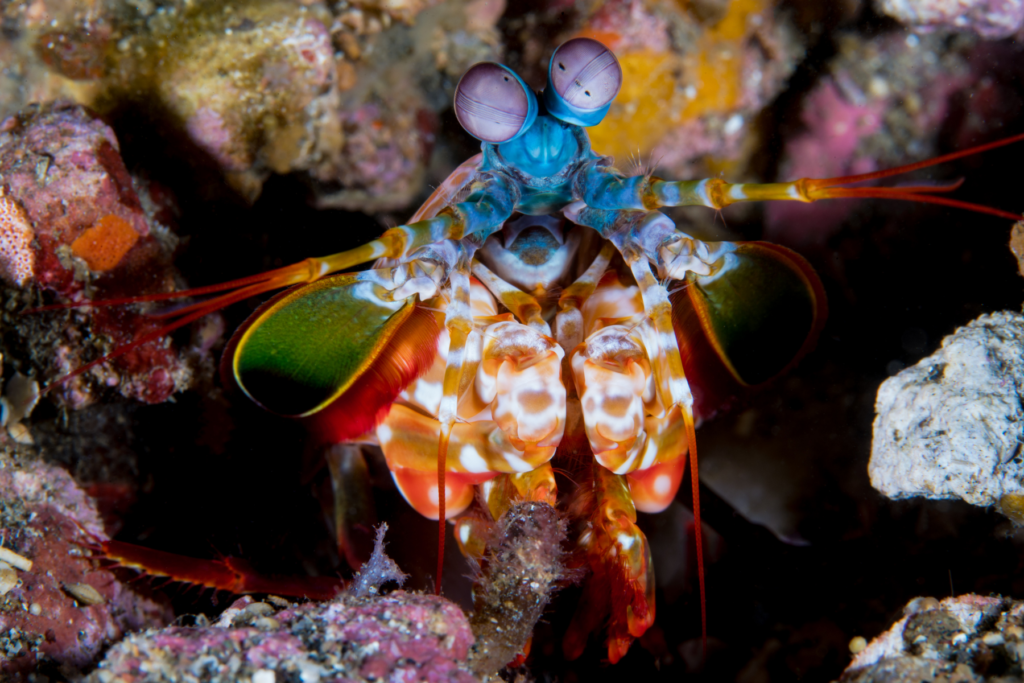
31. Tardigrades are capable of surviving in space.
Tardigrades, or commonly identified as water bears, are microscopic bear-shaped creatures capable of surviving outside earth. These water bears can also withstand even the most extreme environmental conditions and space radiation.
32. The African elephant has the most superior sense of smell.
For most animals, the olfactory function is indispensable for survival, and among the strongest sniffers are the African elephants. Their superb sense of smell helps them find marshy lands, swamps, and rivers even up to 12 miles away.
33. The male praying mantis gets eaten by the female after mating.
Mating shows an act of love between two creatures, but for the male praying mantis, it is a real danger. Most of the time, the female praying mantis tends to consume its sexual partner while mating to receive enough nourishment for its offspring, a behavior called sexual cannibalism.
34. Owls have no eyeballs.
An owl’s eyes are exceedingly large, but they don’t have eyeballs! Instead, owls have cylindrical-shaped eyes held firmly by sclerotic rings. Despite the lack of eyeballs, an owl’s vision at nighttime is far superior to most creatures.
35. Dung beetles use their excrement to fight the hot weather.
Dung beetles do not only rely on others’ animal poop for survival. They also use their own poop to cool themselves during the dry and hot season. They shape their dung into balls and climb atop them so that the poop absorbs their body heat.
36. The Southern Black Racer snake is two-headed.
The Southern black racer is a snake born with two heads. The snake’s unusual body structure can be rooted in bicephaly, a condition wherein twins partially separate from a single embryo, leaving both of them attached to one body.
37. Anacondas and boa constrictors give birth live to their babies.
While most reptiles reproduce by laying eggs, snakes like anacondas and boa constrictors give live birth like mammals do. These viviparous creatures carry their snakelets inside a permeable membrane for five to eight months before their live nativity.
38. Snails are hermaphrodites.
Snails are hermaphrodites or creatures with reproductive organs and cells for both sexes. This biological condition also indicates that a hermaphroditic snail can procreate itself without a mate or sexual partner (asexual reproduction).
39. Male penguins “propose” by giving the smoothest pebbles.
A penguin doesn’t ask its mate’s hand in marriage, but it “proposes” by offering the smoothest pebble it can find to a female penguin to win her over. If the female accepts the male’s gift, both get “engaged” and become mating partners.
40. Snakes are deaf, but they can sense vibrations.
Despite being notorious predators, snakes are deaf and can’t perceive sounds like most animals can since they don’t have eardrums. However, their heightened sense can detect vibrations, allowing them to locate the source of the sound.
41. There are only ten vaquitas in the world.
Vaquitas are small porpoises considered as critically endangered species nowadays, with only 10 of them remaining on the planet. Many organizations have come to find ways on how to save these cetaceans from the brink of extinction.
42. The brown antechinus mates as much as it can for 14 days.
This insect-eating brown marsupial is known for its promiscuous mating activity, lasting up to 14 days long. Not only that, but a single female antechinus has various male partners (better known as polyandry) to have more offspring.
43. Virgin births can happen among boa constrictors.
Virgin births or parthenogenesis happens when a female creature impregnates itself without any sperm involved. This type of asexual reproduction is prevalent among invertebrates but rare with vertebrates. However, in exceptional cases, a female boa constrictor can conceive babies without a male procreator.
44. The deep-sea angler fish has a “light bulb” attached to its head.
The ferocious deep-sea angler fish does not rely on its physical appearance to attract a potential partner but uses the lightbulb atop its head. Surprisingly, the bioluminescent microbes residing in its headlamp are the ones accountable for the glow-in-the-dark effect.
45. Pigs outnumber Denmark’s human population.
Surprisingly, pigs outnumber humans in this small Scandinavian country. Denmark’s primary source of revenue is exporting Danish pork, which is why this country ensures increasing pig livestock.
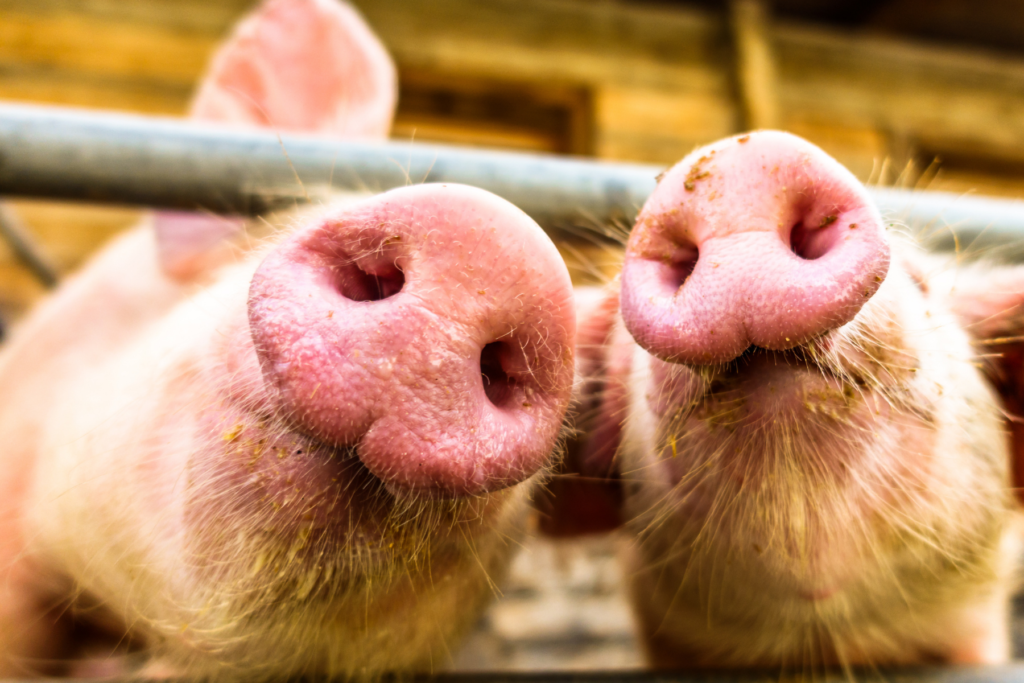
46. Iberian pigs produce the most expensive hams and pork cuts in the world.
The Black Iberian pig is a unique pig breed known to produce the most expensive ham. These domesticated pigs live freely in a cultural landscape called Dehesa and feed on acorns, olives, and nuts, contributing to the ham’s exceptionally nutty flavor.
47. Reptiles can’t regulate their body temperature.
Most cold-blooded animals depend on their environment to stabilize their body temperature. They usually bask in the sun to help warm their bodies.
48. The drum fish produces sounds using its swim bladder.
A swim bladder is every fish’s buoyancy organ, helping them swim hassle-free without getting thrown away by the current. However, the saltwater-native drum fish rapidly contracts and expands the muscle fibers against the swim bladder, creating a drum-like or croaking sound.
49. Dragonflies can fly for up to 35 miles per hour.
These tiny winged creatures are hard to catch, for they can escape from their predators by flying for up 35 miles per hour – fast enough to overtake a professional bicycle racer.
50. Ptarmigans use their snow-white feathers to hide against predators.
Ptarmigans are medium-sized birds dwelling in the cold Arctic regions. What’s interesting about them is their ability to change colors during winter. Their brown feathers turn lighter until their body become snow-white to camouflage during winter.
51. A cow doesn’t have four stomachs; its stomach has four different sections.
Technically, a cow has a stomach divided into four parts: rumen, reticulum, omasum, and abomasum to help the cattle break down its ingested food even without completely grinding it.
52. A male lion is strong enough to haul a 300-kg zebra.
Lions are not known as the king of the jungle for nothing. Specifically, male lions have sturdy and muscular legs and sharp claws and teeth, making it effortless for them to drag even an adult-sized zebra.
53. Most butterflies taste and smell using their feet.
A butterfly neither has a nose nor a mouth, but this six-legged insect has smell receptors surrounding its legs. Its tiny feet also have taste buds used to distinguish its food’s flavor.
54. The Basilisk lizard can vigorously travel on water.
Also known as the “Jesus Christ Lizard,” this Amazon-native reptile can run on water. The skin on its toes unfolds whenever its feet touch the water. Its long tail also serves as its own propeller, thrusting its body while walking briskly on water.
55. Every clownfish is born as a male.
All clownfishes are biologically male at birth, but they have this strange yet unique ability to change their sexes since they have both reproductive glands. They shift into female clownfishes depending on the territory that they’ve chosen.
56. Hens lay at least one egg a day.
It’s easy for hens to lay at least one egg every day because it only requires 24 hours or more to produce its shelled offspring. However, there will be times when hens don’t lay eggs in days, and most of the time, it is normal.
57. Crocodiles swallow stones to help them submerge underwater.
Crocodiles don’t find pleasure in swallowing stones, but doing so helps these reptiles sink underwater. Eating stones also aids food digestion by breaking down the bones of their prey-turned-meal.
58. The Galapagos tortoise can live without eating or drinking for a year.
Food and water are the basics of every living being. However, the Galapagos tortoise can survive without any of those for a year! It consumes a large amount of water to be stored in its bladder.
59. Seahorses mate for life.
Despite the prevalence of polygamy in the animal kingdom, monogamy is still the vocabulary of some animals like seahorses. These creatures choose their forever mates to help them breed successfully for a long time.
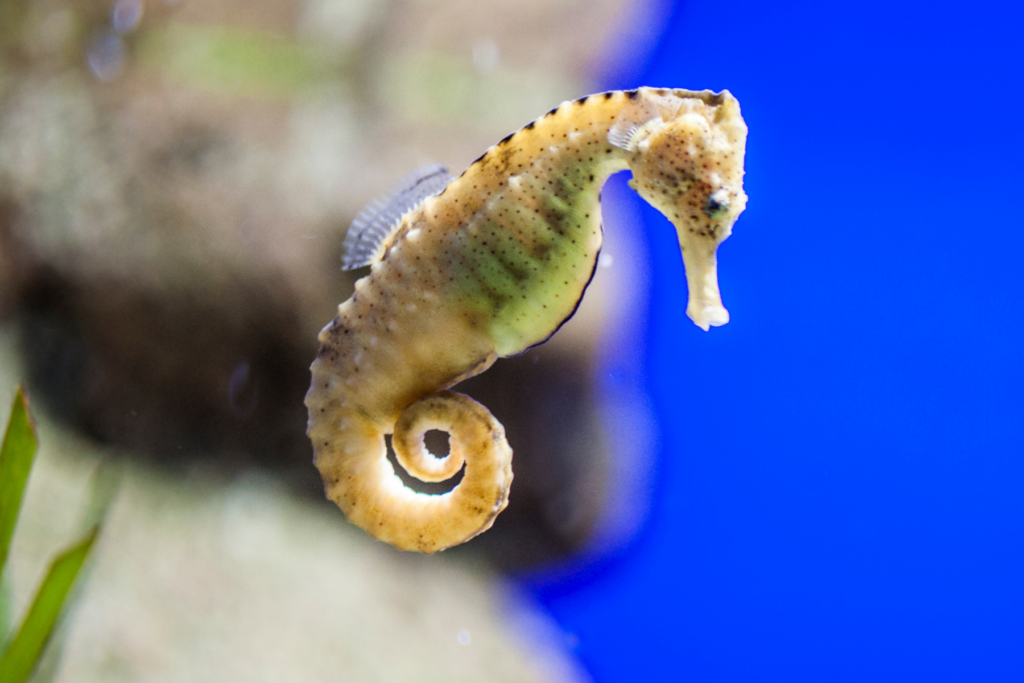
60. The Caribbean spiny lobsters march together during migration.
These migratory crustaceans cling to each other and form a long queue as they relocate to shallow areas. They mass-migrate due to the changes in the water temperature, which usually happens during autumn.
61. A male bower bird decorates its nest with blue shells and blue paint to entice its mate.
Male bowerbirds, which are natives in Australia, have a thing for blue things and use these objects to decorate their nests in the hopes of attracting mates. They can even fly to different areas in search of anything blue –from flowers, sticks, and even bottle caps.
62. Camels are the largest mammals in deserts.
These desert-dwelling creatures can weigh up to 600 kilograms. Camels have one or two humps at their backs which store the fat they need to survive in their habitat’s harsh environment.
63. Giant clams stay on their chosen spots forever.
Since giant clams are immobile sea creatures, they can’t transfer from one reef to another. Once a giant clam has chosen its respective coral reef spot, it stays there forever and only ejects its reproductive cell out of its shell during the spawning season.
64. Many flocks of birds fly in a V-shaped structure when migrating.
Many migratory birds follow a V-shaped formation while flying in groups to decrease wind resistance. They also switch places from being the aviation leader from time to time to preserve energy and let the other rest during their flight. V-shaped formations also make it easier for birds to monitor and communicate with each other.
65. Male grasshoppers can “sing.”
When a male grasshopper wants to find a mate, it sings a mating song by stridulating or brushing its hind legs on its wings to produce a chirping sound. Some also crepitate or make rattling sound using their lungs.
66. A slug doesn’t have four noses.
Slugs don’t have four noses but own two pairs of tentacles for sensing their environment. The first pair detects light and darkness, while the second set of foldable tentacles is for sensing smells.
67. Fer-de-lance snakes can have 60 to 80 venomous babies.
These venomous vipers inhabit different forests of Central and South America. Not only are they lethal, but their females can lay 60-80 eggs and raise a nest of poisonous baby vipers after four months.
68. Elephants create a distinct sound that means “human.”
Alarm calls are common among animals, but elephants have a particular way of telling the rest of the herd when there is a “human.” They make a low-pitched rumbling sound to serve as the “human” warning.
69. A starfish is neither a star nor a fish.
Starfish is a type of echinoderm or elongated multi-armed marine creature with spiky skin. Sea urchins, sea cucumbers, and brittle stars are close relatives of starfish.
70. You can hear a tiger’s roar even if you are 4-5 kilometers away from it.
The tiger’s flat yet stretchable vocal cords are the key to a tiger’s unique ability to roar. Its sound is so loud that you can still hear its cry despite being five kilometers away from the source.
71. The buzzing sound of flies comes from their wingbeats.
When flies buzz, they don’t produce this sound with their mouths, but you’re actually listening to the rapid beat of their wings. They flap their wings briskly to maintain their bodies afloat in the air.
72. No tigers have identical stripe patterns.
A tiger’s stripes help them to camouflage while hunting. Their striped pattern also helps scientists identify them individually since no tigers have the same stripe patterns.
73. Flamingos are actually white-feathered creatures.
These large pink-hued birds are such a beautiful sight, but the truth is, they are grey or white-feathered creatures. They only turn pinkish after absorbing the pink pigments from their blue-green algae and brine shrimp diet.
74. The world’s smallest fish is only 1/3 of an inch small.
The adult cyprinid fish (Paedocypris progenetica), or the tiniest fish in the world, is just less than a centimeter or 1/3 of an inch. Dwarf minnows inhabit the Indonesian and Sumatran swamps and freshwaters and feed on marine plants most of the time.
75. Whales and dolphins are not fish.
These enormous marine vertebrates have fins, but they are aquatic mammals called cetaceans. Like most mammals, dolphins and whales give birth to their live young and nourish them with their milk.
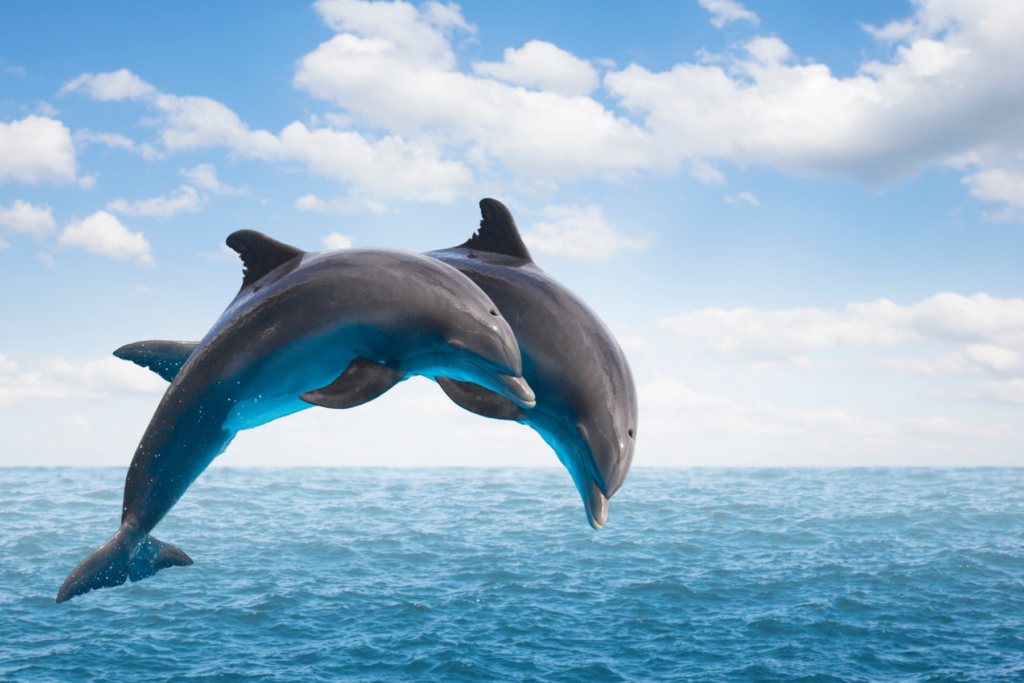
76. You can smell a skunk’s spray from up to three miles away.
A skunk spray contains thiol, a sulfur-based organic compound, which is accountable for the discharge’s rotten scent. Its smell is so putrid that you can smell it even when you’re three miles away.
77. A wolfdog is a hybrid of a dog and a wolf.
Wolves and dogs are close relatives, so it’s possible to cross-breed these canines to deliver a wolfdog. This hybrid may still acquire some characteristics from wolves, so it’s not ideal for a wolfdog to become one’s pet.
78. Glass frogs have translucent skin.
A glass frog’s skin is not 100% transparent, but its see-through skin makes its internal organs visible. Its skin’s unique feature helps the frog to camouflage in the environment.
79. The Vietnamese mossy frog’s skin resembles moss.
The Vietnamese mossy frog is another camouflage expert. Thanks to its green wart-like bumps and spines enveloping its body, it can disguise as moss beneath the rocks underwater.
80. A lovebird does not die after the death of its mate.
Lovebirds may suffer from depression when their partners meet a tragic end or death. However, they won’t necessarily die and will get used to its new situation after some time.
81. Kissing gouramis do not really kiss other gouramis most of the time.
When you see two of these fish species sticking their mouths to each other, they’re not kissing. In reality, they’re showing off to prove one’s dominance over the other.
82. The whistling swan has 25,000 feathers – twice the amount of feathers as eagles.
Birds have 3,000 feathers to protect them, but for the whistling swan, it’s not enough. In fact, it has 25,000 greyish-and-white feathers to cover its entire body.
83. A rabbit can produce babies every month.
In rabbits, gestation only lasts for 28 days, so there’s a big possibility for female rabbits to give birth to a litter of bunnies every month.
84. The Florida Harvester ant is as venomous as a cobra.
Most ants might have stinging bites, but they’re not as lethal as the notorious Florida Harvester, with poison as toxic as a cobra’s venom.
85. Ladybugs can consume over 5,000 insects over their lifespan.
These red-and-black beetles might look tiny on your hands, but their appetite is big enough to feed on more than 5,000 insects while they’re alive.
86. Ostriches, the largest and tallest living birds, cannot fly.
The animal kingdom is abundant with nonflying birds, but ostriches top them as the tallest and heaviest nonflying birds.
87. An eagle’s vision can see five times farther than other birds.
The term “eagle eye” is not just a made-up term, but it’s derived from the fact that an eagle’s visual sharpness makes them one of the most exceptional predators in the world.
88. Bald eagles are not “bald.”
Bald eagles don’t have bare scalps. Because of the white feathers on their head, many have mistaken them as hairless creatures.
89. Young horses can move around and run after childbirth.
After female horses give birth to their live young called foals, these youngsters will start to stand up and slowly walk within an hour.
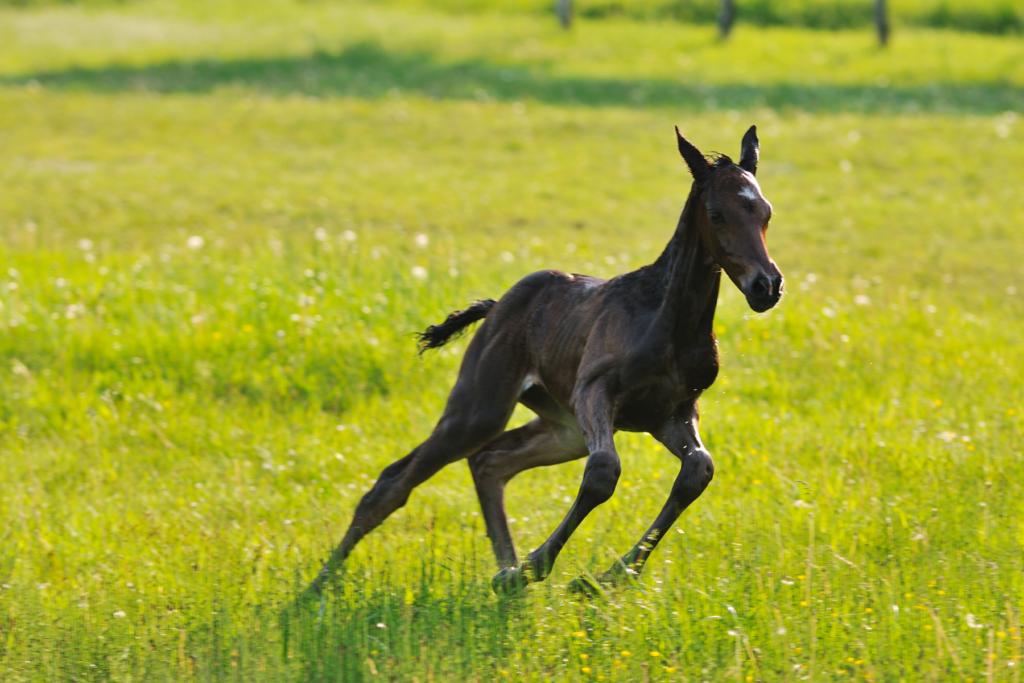
90. An earthworm has five hearts located in different parts of its body.
An earthworm’s “hearts” are heart-like miniature organs responsible for blood circulation.
91. On the other hand, jellyfishes neither have a brain nor a heart.
Yes, it’s rare for living creatures not to have primary organs such as the brain and the heart, but for the jellyfish species, they rely on the nerves on their skin. The sensitive epidermis helps the critter react to its environment.
92. Scorpions are arachnids that give birth live to their offspring.
Arachnids or the eight-legged creatures lay eggs, except scorpions. Instead, they carry their offspring in their uterus and give birth to live nymphs once the gestation period is over.
93. Daddy Long Legs isn’t an actual spider.
What once was thought of as a house spider actually isn’t. Daddy Long Legs belong to a type of arachnids called harvestmen.
94. Millipedes top the list with the most number of legs.
These crawling creatures have 350 legs, too many for their small segmented bodies, but these limbs help them crawl and burrow quickly on dirt.
95. Silkworms can produce more than a thousand threads in six days.
Before a silkworm turns into a beautiful domesticated silk moth, it has to build its home or cocoon by creating thousands of silk threads, which humans are farming nowadays.
96. A cleaner fish cleans the inside of a shark’s mouth without getting eaten.
The remora fish helps a shark’s mouth get rid of the dwelling parasites inside it for free.
97. Most female salmons die after spawning eggs.
Not all salmon species die after laying their eggs, but most salmons do not make it because of the immense current upstream.
98. Giant tortoises have an average lifespan of 152 years.
It’s no surprise that giant tortoises can live for more than a century. Their shelled bodies serve as their food-and-water storage, which can sustain them for years.
99. Meanwhile, a mayfly’s life cycle is good for only 24 hours.
Once a mayfly starts flying, it only has 24 hours to live its life to the fullest by mating and propagating its species.
100. Besides humans, chickens also dream when they sleep.
Studies observed that chickens and their eye movements indicate dreaming while they’re asleep. They can imagine their predators, but scientists have not confirmed this yet.
101. A male Darwin’s frog incubates the eggs inside its mouth until they’re ready to hatch.
Male Darwin’s frogs are super protective of their offspring that they will swallow the eggs and incubate them in their vocal sacs until the gestation period is over.
102. Peacocks show off their bright-colored feathery tails to attract peahens during the mating season.
Peacocks make use of their aesthetic feathers by expanding them to entice peahens to partner with them.
103. The Portuguese man-of-war is actually not a jellyfish.
This free-floating creature is closely related to jellyfishes, but it is actually a siphonophore or a colony of hydrozoans that group together for survival.
104. The Prasinohaema is literally a green-blooded creature.
It’s almost as if this skink (a relative of lizards) is an alien because of its rare green blood. However, the build-up of the green-pigmented biliverdin is the reason behind this biological variation.
105. Turkeys can breed asexually.
Most bird species require the participation of males to prolong their lineage, but some female turkeys can create their own, known as parthenogenesis.
106. There are 1.5 million ants for every living human on earth.
You can find ants in any part of the world, except Antarctica, and as expected, they outnumber the human population, with a 1:1 500 000 ratio.
107. A male swine can orgasm for more than an hour.
Orgasm is normal among animals, especially during the mating period. However, a male swine can experience orgasm for more than 30 minutes that is far superior to humans!
108. Chimpanzees are the most genetically related to human beings.
Human beings are highly related to chimpanzees, with almost 100% genetic similarity.
109. A wombat’s poop is unique for its cube shape.
Because of the intestinal contractions experienced by the wombat, this four-legged marsupial excretes weirdly cube-shaped dung.
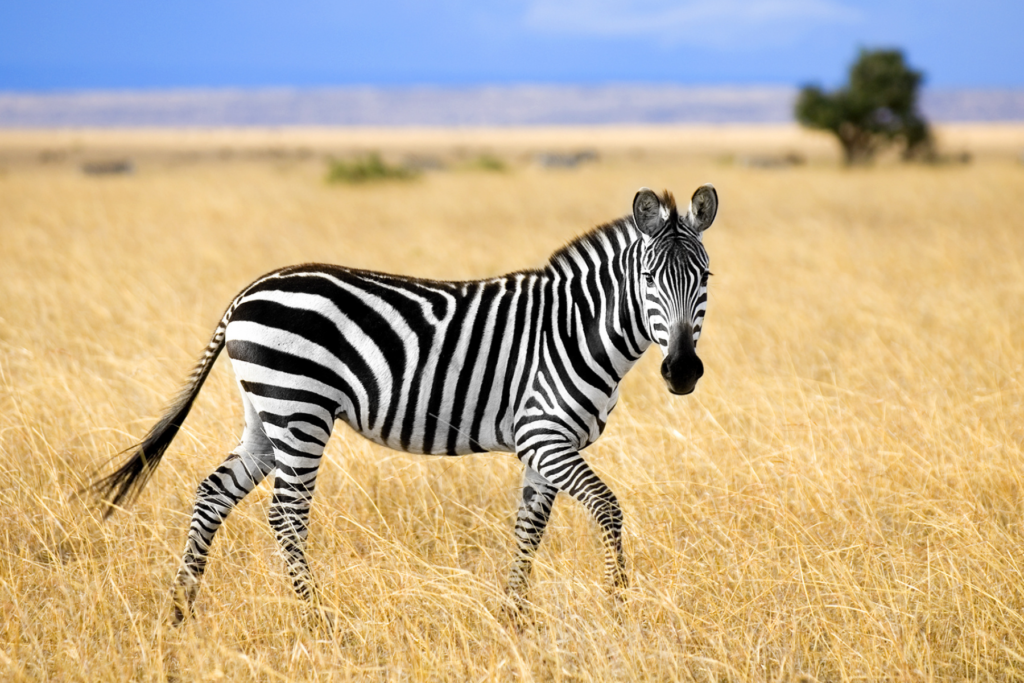
110. Zebras depend on their body stripes for body heat regulation.
Scientists discovered that a zebra’s black-and-white striped pattern also serves as their body’s external cooling system and not just for camouflage.
111. A kangaroo has five “legs.”
The fifth leg is actually the long tail of the kangaroo. These hopping marsupials use their fifth “leg” to power their other four legs and thrust them into the air.
112. Catfishes can survive on land for up to 18 hours.
Catfishes can survive without being on the water as long as their skin remains damp.
113. Slugs have thousands of teeth invisible to the naked eye for eating.
These slimy creatures have a set of tiny teeth called radula which they use for grinding their meals.
114. The Panamanian golden frog is critically endangered because of a “super fungus.”
This frog species is well-known for its unique yellow-bright color. However, this rainforest-native amphibian is on the brink of extinction because of the super fungus chytridiomycosis threatening the lives of many amphibians in Colombian tropical forests.
115. For every three liters of water that a cow consumes, you can obtain a liter of cow’s milk.
Cows are grazing creatures and drink at least 30 gallons of water every day. For every three liters of water they drink, they get to produce one liter of milk.
116. Wolves are born blind and deaf.
These ferocious animals are vulnerable at birth because they are actually born blind and deaf! However, their visual and auditory senses gradually develop weeks after they’re born.
117. Touching the golden poison dart frog’s skin can kill you.
Your curiosity over this poisonous frog can kill you. Its moist skin has glands that secrete a substance called batrachotoxin, which is very lethal to any creature except the host.
118. Blood comes out of a horned lizard’s eye when faced with predators.
When imperiled, a horned lizard’s last resort would be to squirt blood from their eyes in the hopes of driving off the predator.
119. Kiwis have nostrils on their tiny beaks.
These flightless birds use their small nostrils on their beaks to hunt worms and other underground prey.
120. Porcupines have quills six times more than a hedgehog’s spikes.
Porcupines and hedgehogs both have quills that serve as their protector, but the former has 30,000 quills or six times more numerous than the latter.
121. Agalychnis lemur is not a lemur but a tree frog.
The name might be confusing, but the Agalychnis lemur, known as the lemur leaf frog, is a tree-dwelling amphibian inhabiting the rainforests of Costa Rica, Panama, and Colombia.
122. The Cassiopea jellyfish has zero tentacles.
Jellyfishes use their tentacles to sense their environment and catch their prey, but that’s not the case for the Cassiopea jellyfish. It releases a viscous substance to sting its prey or predator.
123. Bulls cannot perceive the red pigment.
Most people think that a red-colored muleta or cloth would irritate bulls and cause them to berserk, but in reality, bulls can only detect two colors, and red isn’t one of them. These muscular cattle react aggressively because of the muleta’s movement.
124. Nephila is a spider that produces golden silk.
This spider does not produce golden silk. However, when the light hits its web silk, it reflects a golden gloss.
125. The suckerfish can stick to sharks without getting chomped.
Remora or the suckerfish can swim side by side with sharks without getting eaten because it feeds on the parasites that stick on sharks. Their relationship is called consumerism.
126. You can’t eat puffer fish unless prepared by an expert.
Pufferfish is a seafood delicacy that needs to be prepared by an expert chef to remove the most poisonous part of pufferfish containing tetrodotoxin.

127. Springhares are mammals that can glow in the dark when exposed to UV light.
Springhare is one of the only mammals that have fluorescent capabilities. Their bodies produce a reddish glow when ultraviolet light hits them.
128. A bee does not survive after stinging another creature.
After stinging, the bee will try to flee away, but since the stinger gets stuck on the surface, its lower body ends up getting torn while pulling the needle.
129. Male fireflies light their lower abdomen to lure mates.
Fireflies make use of a chemical reaction that can cause their butts to glow in the dark. Then, males use their bioluminescent ability to entice females to mate with them.
130. Manatees are the “cows” of the sea.
These aquatic mammals are also known as sea cows because they love grazing a variety of marine grasses.
131. The coconut crab is the world’s heaviest crustacean.
These gigantic crustaceans, which are closely related to hermit crabs, weigh about 14 kilograms.
132. The black string surrounding a shrimp’s body is its intestinal tract.
Before cooking these fresh crustaceans, make sure to devein or remove the surrounding black string. It is actually the shrimp’s intestine that contains its dirt.
133. Leeches own 32 brains.
A leech is a soft-bodied bloodsucker with 32 segments, each having its own brain.
134. Elephants cannot jump.
Unfortunately, these colossal walking mammals cannot move up and down. Their skeletons do not have a spring to induce and support any upward movement.
135. Greyhounds can run up to 45 miles per hour – fast enough to catch up to a moving car.
These domesticated canines are the fastest dog breeds on earth, topping most of the dog-racing competitions.
136. Heterochromia is a common condition among Siberian huskies.
Most Siberian huskies have two different eye colors because of an eye condition called heterochromia. It can be rooted in a genetic modification related to melanin production.
137. Chameleons can change colors because of their chromatophore cells.
Chameleons are camouflage champions because of their skin’s abundant chromatophore cells responsible for producing various hues.
138. Male humpback whales can “sing” for up to 20 minutes during the mating season.
This romantic colossal marine mammal allures the females by “singing” or simply producing grunts, whistles, and whoops lasting for up to 20 minutes long.
139. Hog-nosed snakes pretend to smell dead to trick and drive predators away.
Not only do these semi-venomous reptiles play dead to escape carnivores, but they also emanate a rotten odor to mimic how a dead creature smells to make it even more convincing.
140. A cobra’s venom is a potential ingredient for medications.
Venomous cobras have found their role in the world of medicine. Their poison has proteins used for creating different drugs against various diseases.
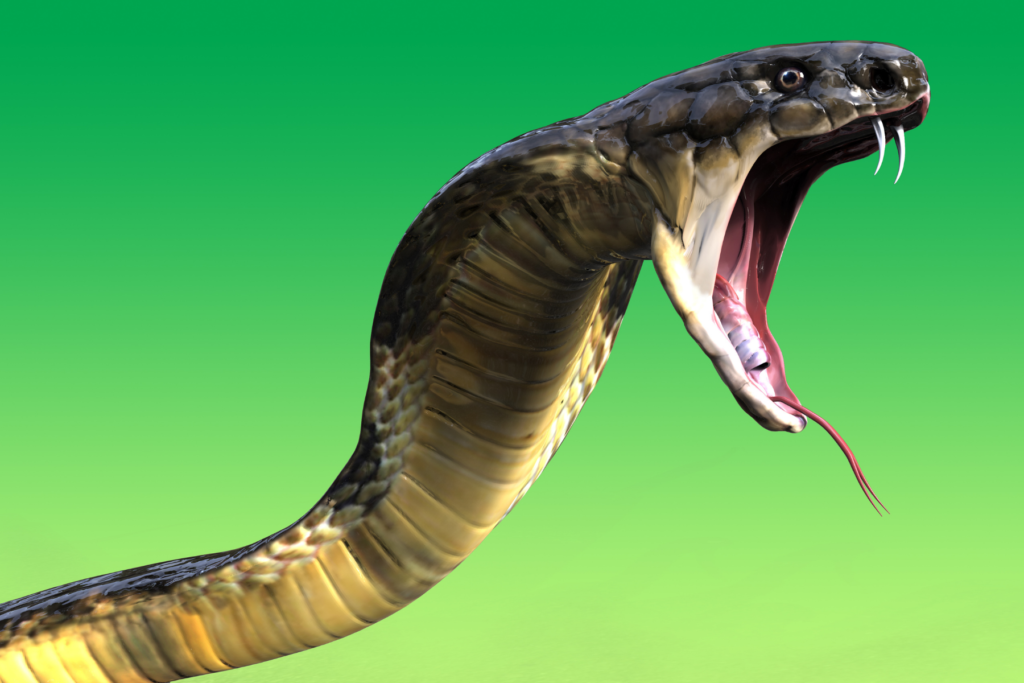
141. Some dogs can identify if someone has cancer.
Some dogs have an ultra-sensitive sense of smell and can recognize the specific scent of blood samples with cancer cells.
142. Not all crows are black-feathered.
Forget the black crow in Noah’s Ark, for white crows do exist. Also known as the albino crow, they are white-feathered due to a genetic mutation.
143. The bee hummingbird lays the smallest shelled egg on the planet.
Bee hummingbirds are not only cute-sized creatures, but they also produce the tiniest shelled eggs, as small as a coffee pod.
144. Many catfish species have thousands of taste buds enveloping its body.
Thousands of taste receptors are present in catfish skin, helping these freshwater creatures detect and savor their meals.
145. Tarsiers kill themselves when they get overstressed.
These nocturnal primates become suicidal when their stress builds up due to captivity and fear. If they can’t handle stress and anxiety, they tend to bang their heads on the tree until they die.
146. Corals are not sea plants but are animals.
These colorful embedded homes of most marine animals are actually animals, too. They are immobile invertebrates and survive by consuming the algae attached to their bodies.
147. Only female mosquitoes transmit the dengue virus.
The female Aedes aegypti is the sole spreader of the dengue virus since the mouths of male mosquitoes cannot penetrate through the human skin.
148. A botfly uses the mosquito to transmit its eggs into the host’s skin.
Botflies capture mosquitoes and inject their eggs into them. When the mosquito bites an animal or human, the eggs are transmitted and develop into larvae after a week.
149. The bigger the rooster’s wattle, the greater chance to get chosen by hens.
A rooster’s wattle or the skin atop its head serves as an attractive factor for hens when choosing their mates. Roosters with bigger-sized wattles have the advantage.
150. Your dog can smell you even if you’re 20 kilometers away from it.
Dogs are olfaction champions, with their noses having 300 or more sensory receptors to detect different scents. Their sense of smell is so sensitive that they can perceive you 20 kilometers away from them.
151. The female Laysan albatross lays only one egg per year.
This bird species has a smaller avian clutch size and only spawns one egg every year.
152. The sunflower sea starfish can grow 24 arms.
Not all starfish species resemble a star. As a matter of fact, the sunflower sea star has 24 long arms.
153. Chimpanzees and orangutans know how to laugh.
Some animals like chimpanzees and orangutans giggle in response to a tickling sensation they experience when they play with each other.
154. Houseflies use their legs to taste what they eat.
Before a housefly fills itself with a meal, it does a taste test first using its legs with gustatory receptors.
155. A scorpion’s body can radiate under UV light.
Like springhares, scorpions also glow when exposed to ultraviolet light because a part of their exoskeleton’s cuticle called the hyaline layer consumes the UV light and illuminates.
156. Red salamanders are lungless semi-aquatic creatures.
These red-skinned amphibians don’t have chambers for breathing but inhale and exhale through their moist skin.
157. The pink fairy armadillo has a blush-colored armored shell.
The smallest member of the armadillo clan is unique for its beige fur and blush-colored armor, opposing the features of most armadillo species.
158. The Australian tiger beetle is faster than the cheetah.
Being small isn’t a disadvantage for the Australian tiger beetle, which can run for up to eight kilometers per hour despite its small size.
159. Peacock feathers come in 12-15 colors.
Peacock feathers are visually gratifying because they come in 12 to 15 different color combinations. These fowls use their brightly-colored feathers to bewitch their mates.
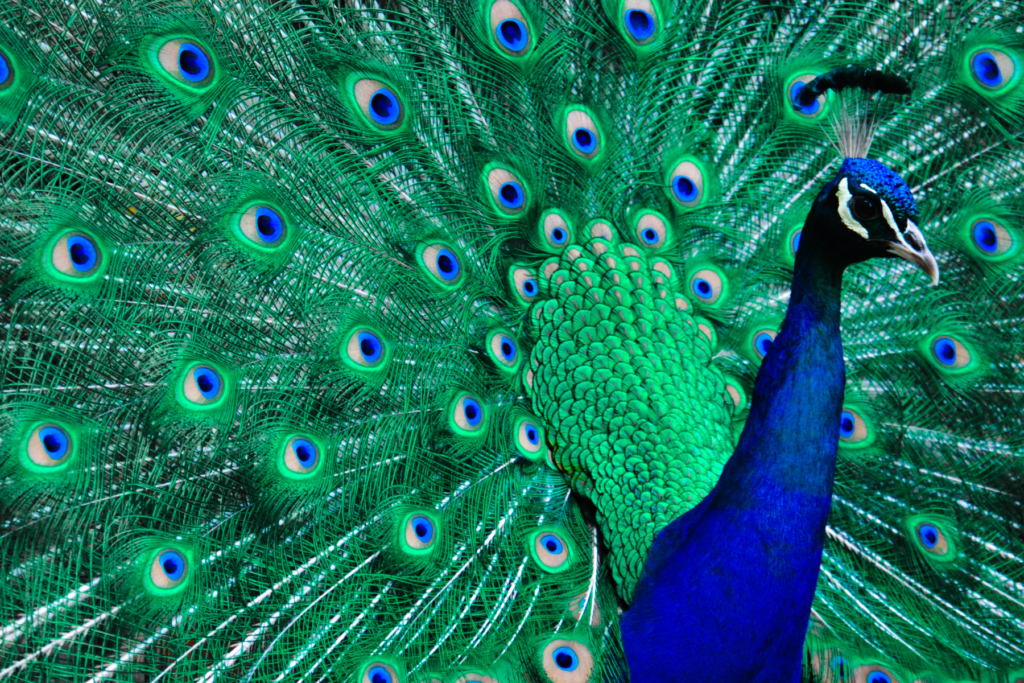
160. Most spiders use their eight eyes for catching prey.
Besides having four pairs of legs, these arachnids also have eight eyes for hunting. Some of a spider’s eyes are for light detection, while the others are for identifying prey and predators.
161. A blue whale consumes at least 3 600 kg of krill every day.
Krill, or the mini crustaceans resembling shrimps, are the most beloved snacks of blue whales that they can consume three tons of these tiny critters in a single day.
162. The oldest living giant tortoise is currently 189 years old.
Giant tortoises are not immortal, but they have an extremely long lifespan mainly because of their slow metabolism. Jonathan, the tortoise’s name, currently resides in Saint Helena Island in the South Atlantic Ocean.
163. Beavers release a secretion that smells like vanilla.
Beavers are territorial creatures that use their secretion to mark their area. Unexpectedly, this gooey substance, which smells similar to vanilla, is used as an alternative food flavoring.
164. Burying beetles preserve their food with their own discharge.
These scavenging insects excrete an antibacterial substance that helps them preserve their newfound animal carcass. Then, they bury their food on earth, as their name suggests.
165. Some termites become “suicide bombers” during a colony attack.
To protect their home base, some termites blow up their abdominal sacs containing toxic secretions.
166. Dogs smell each other’s butts in search of potential mates.
A dog’s butt has apocrine glands that release a specific odor that reveal a creature’s basic information, such as age and gender. Dogs can even determine if the other is a suitable mating partner by simply sniffing each other’s bottoms.
167. Platypuses are mammals that can lay eggs.
The duck-billed platypus is one of the only two mammals that don’t give birth to their live young. Instead, it lays mammalian eggs but still produces milk for them after hatching.
168. Dogs are attracted to frogs because of the scent of their skin.
It’s normal for your pet dog to approach a jumping frog because these amphibians excrete an odor that is attractive to dogs, but toxic.
169. The sea cucumber ejects its toxin-covered internal organs toward its enemy.
When cornered by a predator, the sea cucumber shoots the enemy with poisonous parts from its gut.
170. Kangaroos can actually flatulate– or fart.
Zoologists used to think that kangaroos couldn’t expel gas because of a lack of a certain kind of methane-producing bacteria in their guts. However, they do have low amounts of these microbes and can, in fact, flatulate.
171. Jewel beetles use their glossy feature to hide from enemies.
Their rainbow-colored or iridescent armors are not just for aesthetics; they take advantage of the changing colors to deceive their predators.
172. Komodo dragons are lizards, not dragons.
Their split-tongues resemble those of a dragon’s, but in reality, they are enormous-sized lizards that inhabit the tropical forests and islands of Indonesia and other Southeast Asian countries.
173. An alligator’s eyes illuminate in the dark.
An alligator’s visual acuity at nighttime is superb, making them great predators in the dark. Their eyes also have a tissue at the back to reflect the light that shines on them.
174. Lobsters can’t endure the freshwater.
Unfortunately, most lobsters can’t survive for too long in freshwater. Their cells would keep on absorbing the water and may end up bursting, causing these poor crustaceans to die.
175. Snail mucus is an expensive and in-demand skincare ingredient.
The snail’s sticky slime is a holy grail component for most beauty products. It has potential skincare benefits such as collagen production and cell regeneration.
176. Frogs puff up their bodies when faced with threatening predators.
In a life-or-death situation, frogs defend themselves by inflating their bodies to enlarge their size in the hopes of tricking their attackers.
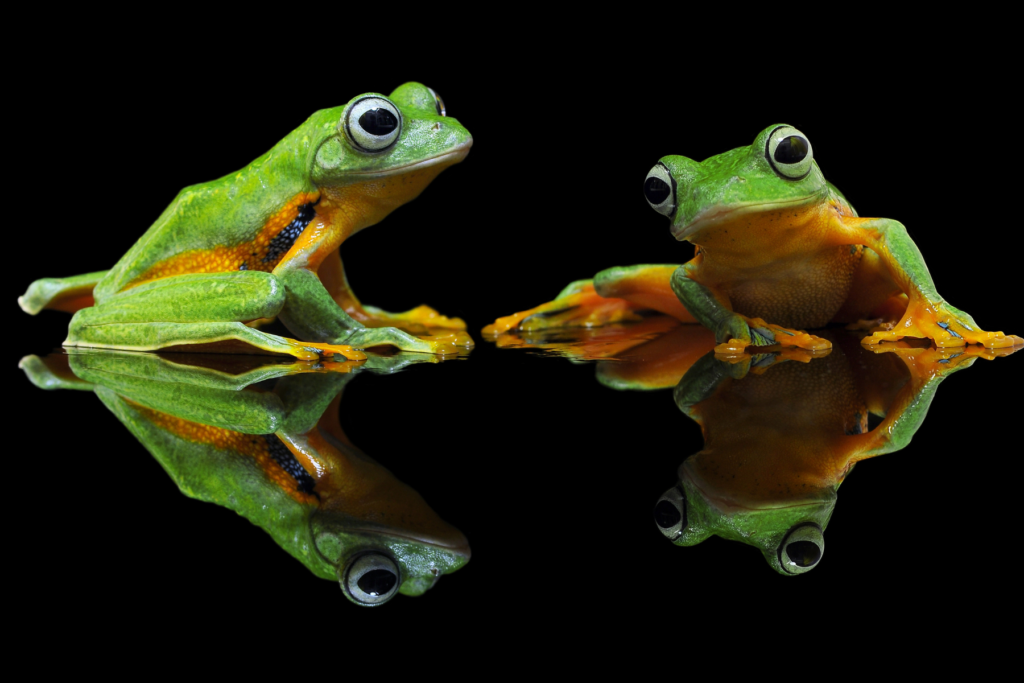
177. Desert rain frogs can live for up to 15 years.
Unlike most amphibians, these sand-skinned frogs have biologically adapted to the dry conditions of their habitat, which is why they can survive longer than most of their relatives.
178. Swordfishes don’t form schools; they live in solitude.
A swordfish is an antisocial critter, but it’s not solitary forever. It still interacts with some marine animals, especially during the mating season.
179. A sperm whale’s brain is almost six times larger than a human brain.
Whales are gigantic mammals, so it’s no surprise that a human brain’s size is incomparable to an adult sperm whale’s colossal brain.
180. A giraffe’s neck can’t touch the ground.
The giraffe’s neck is almost half the length of its whole body, which makes it even more difficult for its neck to reach the floor surface. It has to spread its front legs when consuming something on the ground.
181. Adult ostriches run so fast that they can catch up to cars with a speed of 70 km/h.
Thanks to ostriches’ muscular and long-legged structure, they can race with a moving car at 70 kilometers per hour.
182. The river hippopotamus does not know how to swim.
Although these gigantic muscular mammals reside in waters, they don’t swim but can walk in shallow waters for food hunting and cooling.
183. A goldfish’s memory lasts for more than three seconds.
Contrary to common belief, the memory of a goldfish is better than expected. In fact, it can remember previous events from two weeks ago.
184. Moray eels have two different mandibles.
Moray eels have one permanent jaw and another retractable one to help these elongated fish to swallow their food of the day.
185. A dolphin species can survive in the freshwater.
Most dolphins live on seas and oceans, but river dolphins inhabit the Amazon Rivers. It also turns out that these particular cetaceans are also famous for their unusual pink color.
186. The Canterbury mudfish can sustain its life outside water for up to 85 days.
This one-of-a-kind mudfish species can breathe through its skin and slow its metabolism to conserve energy, making it a tough semi-aquatic survivor on land.
187. Bats are the only mammalian species that can soar high in the sky.
Birds and insects are not the only creatures that dominate the air. Bats can also fly, making them the only mammals with this unique ability.
188. Opossums “play dead” in response to threats.
If opossums can’t beat their enemies, their bodies involuntarily play dead or undergo a comatose state as an after-effect of extreme fear.
189. Pandas have a unique bone used for eating bamboos.
Pandas have another bone embedded in their hands called the sesamoid bone that aids them when holding their favorite food – bamboos.

190. Bullfrogs are sleepless amphibians.
When an animal sleeps, its brain becomes less active. However, studies have shown that a bullfrog’s response to any stimulus does not change or falter whether it is resting or not.
191. Polar bears usually have twins as their offspring.
These white-furred winter mammals have evolutionarily adapted by giving birth to twins to increase their odds of survival.
192. When a chameleon catches its prey, its tongue can extend longer than its body length.
Chameleons use their long tongues to eat their target and can stretch longer depending on the prey’s location.
193. Despite feeding on dying animals, vultures don’t usually get infected.
Vultures love scavenging on dying and dead creatures, but they don’t get infected. Vultures are not 100% immune, but their stomach acids with a pH level of 1.0 are corrosive enough to decompose almost all bacteria and viruses. Vultures are considered salient members of the ecosystem yet major disease carriers in the animal kingdom.
194. Sea urchins are 100% boneless sea critters.
Despite their spiky bodies, sea urchins are absolute boneless marine creatures since they belong to the phylum Echinodermata or soft-bodied sea critters. Sea urchins are sturdy not because they have bones but because of their outer shells made from calcium carbonate.
195. Spiny anteaters are mammals that don’t produce milk for their offspring.
Monotremes are the only oviparous mammals. Because echidna or the spiny anteater is a monotreme, it neither produces milk nor feeds its young with milk.
196. Frogs don’t dwell in saltwater regions.
You won’t find frogs in seas and oceans because their tadpoles won’t survive the water’s high salt content. Frogs are also at risk of dehydration when submerged in saltwater.
197. Paws can help dogs regulate their body temperature.
Some domesticated animals, such as dogs, don’t sweat as humans do. Their paws have tiny sweat glands that help them cool down.
198. Locusts are water-proof insects.
The bodies of locusts or the bigger versions of grasshoppers are coated with a wax-like water-proof substance.
199. The African driver ant can spawn millions of eggs per day.
The ant colony has a queen responsible for bearing offspring, and it usually lays 800 eggs a day, but the queen of the African driver ant colony can spawn three to four million eggs in a single day.
200. Cats slumber for up to 16 hours every day.
Big cats sleep for prolonged hours in a day to preserve their energy in preparation for their hunting spree. Some cat species, especially domesticated ones, still have this habit of sleeping for 12 to 16 hours per day.


